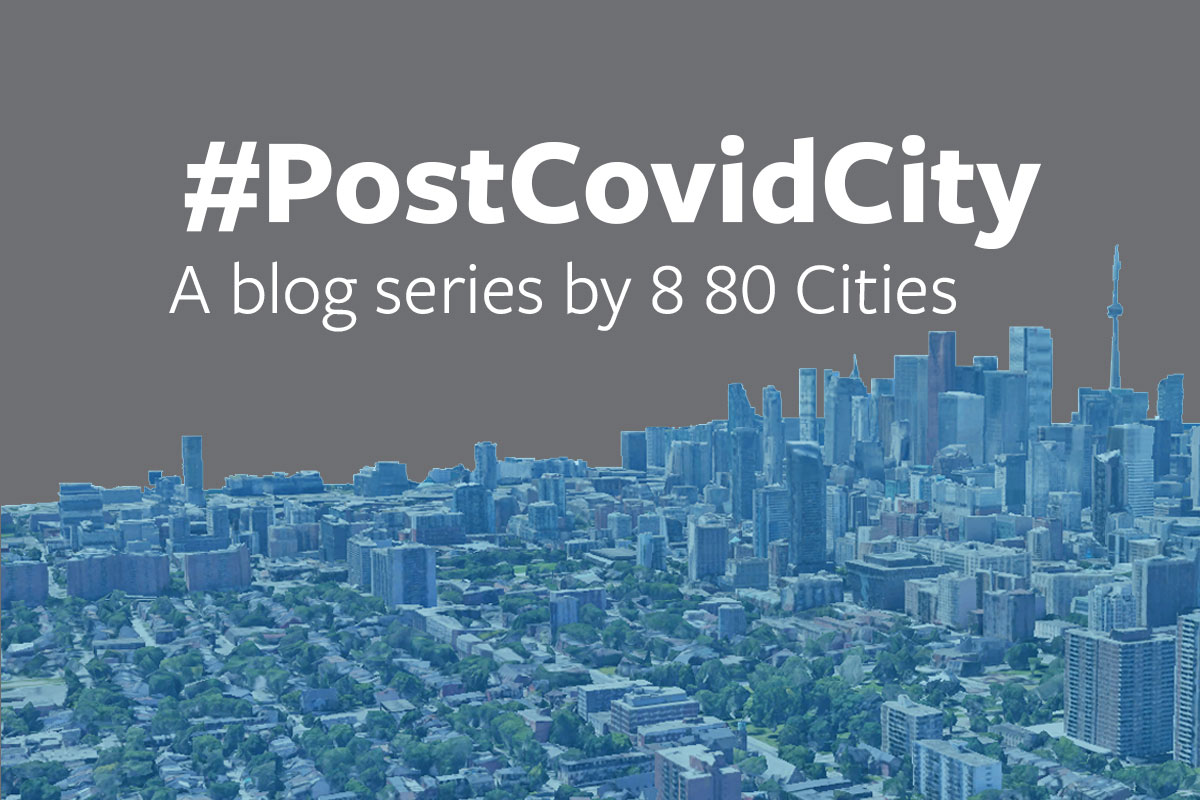
27 Apr #POSTCOVIDCITY: How to Create a More Equitable Public Realm amid COVID-19
#POSTCOVIDCITY is an 8 80 Cities blog series exploring the impacts of COVID-19 on city-building and public space.
Amidst an unprecedented global pandemic, city leaders have made bold decisions to flatten the curve of COVID19. We applaud the efforts of these leaders who have introduced physical distancing measures and undoubtedly saved lives, protecting some of our most vulnerable residents.
As an organization that focuses on improving the quality of life for people living in cities no matter their age, ability, or socioeconomic status, we are monitoring the impacts of COVID19 on people’s daily quality of life.
We believe, in order to create better cities for all, city builders of all kinds and at all levels, need to be able to engage in a productive dialogue on the implications of the decisions they make. We all need to be willing to interrogate the underlying systemic and structural inequalities that are often tied up in these decisions. In the spirit of furthering discourse and our mission of creating better cities for all, we realize we’ve collectively got a few things we need to get off of our chests.
For thirteen years our organization has strived to achieve more equitable and human-centred mobility and public space in cities. As we sit around the 3-month mark into this crisis we have observed that the important and necessary physical distancing interventions have also amplified systemic inequalities in the public realm that tend to marginalize walking, cycling and transit and prioritize car dependency.
Some of the challenges related to the public realm we want to highlight are:
• Sidewalks are too small to maintain physical distancing
Sidewalks do not allow one person to pass another while maintaining the World Health Organization’s physical distancing guidelines. Whether it is individuals walking in the line of vehicular traffic to avoid run-ins with others or simply breaking physical distancing measures, the lack of space to safely navigate cities poses avoidable risks to one’s health. These risks are only exacerbated if you are a child, an older adult, or rely on a mobility support aid as your ability to detour around others is limited.
• Increase in vehicular speeds
Cities have reported an uptake in dangerous driving habits amidst Covid-19. High speeds are a leading factor in fatal collisions. Road violence, especially during a global health pandemic, are unwarranted pressures to front-line health workers.
• Inadequate safe and accessible travel routes
Front-line essential workers and those needing to visit essential services require a safe route to travel. We recognize the challenges cities are facing with modifying public transit routes to avoid excessive crowding.
• Discriminatory judgements
Misguided judgements and police interventions in public space disproportionately fall on children, racialized people, and people experiencing homelessness. While upholding physical distancing guidelines is of utmost importance, the right to access free public space for the purposes of mental and physical health must be shared.
The good news is that there are things cities can do quickly to address some of these challenges. While some are tweaked to reflect our Covid19 reality, mostly they are just good old fashioned tried and tested approaches to creating a safer and more equitable street design for people.
Here are four things cities can do to better manage streets and public space equitably amidst the pandemic and beyond:
1. Eliminate the pedestrian crossing button
The benefits of altering street light signals to automatically stop traffic for pedestrian crossing is three-fold. It first prioritizes the safety of vulnerable road uses by creating safe opportunities for street crossing. It also limits the number of surfaces one must touch, helping curb the spread of infection. Lastly, it calms vehicular traffic. While speeding and dangerous driving have been reported to be on the rise, eliminating the pedestrian crossing button forces drivers to slow down and stop for pedestrians.
2. Expand street space for walking and cycling
8 80 Cities has done a lot of working in planning and promoting >Open Streets globally. Open Streets is a program where key arterial streets are closed to cars and opened to people for recreation. Traditionally open streets are on lower car traffic days like Saturdays or Sundays to take advantage of underused public space and reclaim it for people. Whereas the benefits of Open Streets bore fruit before Covid19, many cities have adapted the idea and adopted #CovidStreets. In the era of Covid19 Open Streets are less about bringing people together, and more about keeping people in motion and safely apart. Many cities have opened streets to facilitate safe walking and cycling for travel especially to those serving at the frontlines. This has also helped alleviate crowding on public transit where there are increased risks of contracting and spreading the virus.
We’ve also had the pleasure of working on many pop-up street makeover projects. We know that transforming streets can happen in a matter of hours, with simple low-cost signage and barriers, much of which is already in a city’s existing inventory.
Here are some strategies for opening streets amid the pandemic:
• Re-allocate vehicle lanes to people lane(s)
On commercial streets where traffic volumes are down and where there is pressure on sidewalks due to queuing in front of grocery stores, pharmacies, and other essential businesses, eliminate on-street parking and re-allocate the space for expanded sidewalks. On streets with four or more vehicular travel lanes reduce vehicle lanes (from 4 to 2) to open up space for temporary bikeways and wider sidewalks to accommodate physical distancing.
• Create ‘Slow Streets’/ ‘Shared Streets’
On low traffic volume streets, restrict vehicular access to local traffic only so that people walking and cycling can more safely occupy the whole street and maintain physical distance. This is best implemented widely across the city to reduce the possibility of creating destinations where people congregate. For example, Oakland’s “slow streets” occupy about 10% of the city’s street network. Simple signage goes a long way and makes it easier for more vulnerable road users, especially children and older adults to feel comfortable taking up space where cars are allowed but moving at very slow speeds.
• Open Streets
Fully close off streets to cars and open them to people. This is best done in coordination with other street interventions (above) to reduce the possibility of attracting crowds or creating a destination. The most successful approaches we’ve seen amid the pandemic have been opening up parallel routes to linear parks to relieve congestion in larger more populated parks. In addition, many cities have created open street corridors facilitating safe active travel based on existing routes that were previously used mostly for recreation. For example, Bogota’s 75 miles of open streets that traditionally only operated on Sundays were opened up every day of the week to provide space for walking and cycling for essential travel.
Strategies to expand street space for walking and cycling is not just a band-aid solution to the challenges presented by Covid-19. These strategies fundamentally prioritize the safety and wellbeing of people walking and cycling. A silver lining to COVID-19 is an opportunity to reimagine our streets for their purpose and design.
3. Keep parks and outdoor public spaces open for equitable access to the mental and physical health benefits
Getting physical activity and time outside is vital to one’s mental and physical health. While playgrounds and amenities must be closed, park space can still be safely used for walking and bicycling while maintaining physical distance. Having access to private outdoor space like backyards or balconies to safely enjoy fresh air and exercise at home is a luxury that many people in cities do not have. People living in poor, unsafe, or dangerous conditions, bear a much heavier burden amid the stay at home orders. We also know that neighbourhood access to park space is strongly tied to socioeconomic factors, where low-income communities tend to be more park deprived. Cities must keep parks and public spaces open for people to enjoy the benefits, and in some cases work to create more safe spaces that accommodate pandemic-safe recreation (see create more space for walking and cycling above).
4. Lead with clear intention, monitor, then iterate
Good leadership is not being able to anticipate every single risk and consequence of a decision. Good leadership is making informed decisions, building in an effective response mechanism, and iterating. This approach to leadership has been apparent during this crisis and can be applied to parks, streets and open spaces.
A city’s public space is a complex interrelated ecosystem. When a public space intervention, like the ones we recommend above, are planned and executed, they will need careful monitoring and evaluation. These monitoring and evaluation methods need to be able to show how interventions are performing in relation to the goal they seek to achieve and target audiences. This means, that data collected needs to be broken down by demographics (race, age, etc.) to illuminate how individuals may be disproportionately impacted. If equity is an afterthought in managing public space, history tells us there will be massive blind spots related to the complicated social dimensions of public space, more car-centric planning, and the status quo will reign.
It’s clear that cities play an integral role in the larger strategy to fight Covid19. While the simple public space initiatives detailed above are based on current findings, we are reminded that cities need to be flexible and proactive in the ways that they can respond to community needs. Each of the strategic actions noted can be taken by city leaders of all levels to help pave a way towards a #PostCovidCity.
We at 8 80 Cities are committed to following and sharing insights along this journey in a and towards a #PostCovidCity. To this end, we will be rolling out a #PostCovidCity blog series that continues this critical discussion about how cities need to adapt towards a more livable and resilient future for all residents.



